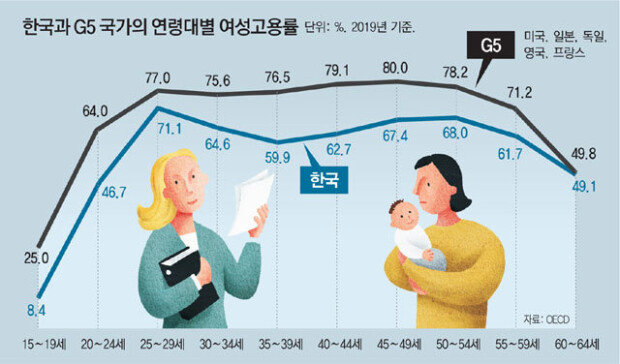Female employment rate in Korea is M-shaped
Female employment rate in Korea is M-shaped
Posted March. 19, 2021 07:35,
Updated March. 19, 2021 07:35

Recent statistics show that more South Korean women drop out of the labor force in their 30s than their counterparts in other OECD nations. Seoul’s female employment rate exhibits an “M” shape as opposed to a U shape that is commonly found in major advanced countries.
According to the Korea Economic Research Institute on Thursday, 57.8 percent of South Korean women were employed in 2019 ranking 31st among the 37 OECD countries, while it was ranked 33rd for the female labor force participation rate in the same year, which stood at 60.0 percent. This means South Korea has one of the lowest rate of women who are willing to have a job let alone of employed women.
Employment rates by age group reveal that many South Korean women leave the workforce in their 30s to raise children, struggling to balance work with family. The labor force participation rate of women in South Korea is “M”-shaped. It reaches its peak at 71.1 percent for women ages between 25 and 29 before it falls dramatically as they reach their 30s to 64.6 percent for women ages between 30 and 34 and to 59.9 percent for women ages between 35 and 39. It then picks up with 62.7 percent of women ages between 40 and 44 and 67.4 percent of women ages between 45 and 49 participating in the labor force. It drops again for women ages between 50 and 54.
On the other hand, the female employment rates of five advanced nations, which are the United States, Japan, Germany, the United Kingdom and France, exhibited a “U” shape where the numbers increase until women reach their 40s. The difference between the rate in South Korea and the average rate of the five countries is only 5.9 percentage points for women ages between 25 and 29, but the gap gradually widens to 16.6 percentage points at 35~39 before it narrows for women in their 40s.
The difference was most prominent among women with children who are younger than 15 at 57.0 percent verses 72.2 percent. In a survey of economically inactive women conducted in 2020 by Statistics Korea, 65.0 percent of the respondents reported that they feel pressure about raising kids and doing housework.
The Korea Economic Research Institute said South Korea lacks a flexible labor market and support for women compared to the G5 countries where 14.9 percent of employed women are working part-time, as opposed to 8.9 percent in Seoul. The figure goes as high as 17.2 percent in the United Kingdom and Japan. South Korea also spends less (0.4 percent of the entire spending) than the five countries (1.5 percent on average) to provide support for working mothers including paid maternity leave, grants and tax benefits.
“To help women to stay in the workforce, more support should be provided such as by increasing the number of child care facilities and promoting parental leave,” said Chu Gwang-ho of the Korea Economic Research Institute. “It is also important to make the labor market more flexible, which will help create more part-time jobs.”
will@donga.com
Headline News
- Med professors announce intention to leave hospitals starting Thursday
- Bridge honoring Sgt. Moon Jae-sik unveiled in Pennsylvania
- Chief of Staff Chung tells presidential secretaries to stay away from politics
- US FTC bans noncompete agreements
- N. Korea launches cyberattacks on S. Korea's defense companies







